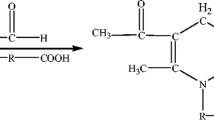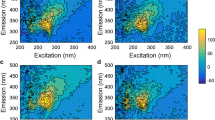Abstract
A procedure based on a D-optimal design coupled with PARAFAC was proposed to optimise signals from molecular fluorescence spectroscopy to obtain the best experimental conditions for the achievement of the best fluorescence signal of green tea samples. Excitation-emission signals (EEMs) were used to analyse the liquid samples (tea infusions), whereas front-face fluorescence excitation-emission matrices (FFEEMs) were recorded for the solid samples (raw or powder tea leaves). The experimental effort was reduced considerably in both cases thanks to the D-optimal design. Once the optimal conditions have been found, the characterisation of green tea was carried out and the sensitivity and specificity were evaluated. The projection of the principal component analysis (PCA) scores enabled to differentiate among the types of liquid green tea (Chinese tea, Chinese tea with lemon and Indian tea with and without theine). The discrimination of solid green tea according to its geographical origin (Chinese, Indian and Japanese) was also carried out through PCA. In addition, the discrimination between the most expensive Japanese tea and the cheapest one was possible. The sensitivity of the models built with SIMCA was 100% and the specificity of the models for the Chinese tea with respect to the Japanese tea was also high.







Similar content being viewed by others
References
Andersson CA (1998) INCA 1.41. Department of Food Science, University of Copenhagen, Denmark. Available from: http://www.models.life.ku.dk/inca. Accessed 30 Nov 2018
Arts ICW, Hollman PCH (1998) Optimization of a quantitative method for the determination of catechins in fruits and legumes. J Agric Food Chem 46:5156–5162
Balentine DA, Harbowy ME, Graham HN (1998) Caffeine. In: Spiller GA (ed) Tea: the plant and its manufacture; chemistry and consumption of the beverage. CRC Press, USA, pp 35–72
Bro R, Kiers HAL (2003) A new efficient method for determining the number of components in PARAFAC models. J Chemom 17:274–286
Cabrera-Bañegil M, Hurtado-Sánchez MC, Galeano-Díaz T, Durán-Merás I (2017) Front-face fluorescence spectroscopy combined with second-order multivariate algorithms for the quantification of polyphenols in red wine samples. Food Chem 220:168–176
Carloni P, Tiano L, Padella L, Bacchetti T, Customu C, Kay A, Damiani E (2013) Antioxidant activity of white, green and black tea obtained from the same tea cultivar. Food Res Int 53:900–908
Casale M, Pasquini B, Hooshyari M, Orlandini S, Mustorgi E, Malegori C, Turrini F, Ortiz MC, Sarabia LA, Furlanetto S (2018) Combining excitation emission matrix fluorescence spectroscopy, parallel factor analysis, cyclodextrin-modified micellar electrokinetic chromatography and partial least squares class-modelling for green tea characterization. J Pharm Biomed Anal 159:311–317.
Dong Y, Lu H, Yong Z, Yan C, He S (2015) Fast two-dimensional fluorescence correlation spectroscopy technique for tea quality detection. App Optics 54:7032–7036
FAO (2015) Word tea production and trade. Current and future development, Rome
Forina M, Lanteri S, Armanino C, Casolino MC, Casale M, Oliveri P (2012) V-PARVUS 2012. An extendable package of programs for explorative data analysis, classification and regression analysis, Dept. of Pharmacy, University of Genoa.
Gonçalves Dias Diniz PH, Ferreira Barbosa M, Tavares de Melo Milanez KD, Pistonesi MF, Ugulino de Araújo MC (2016) Using UV–Vis spectroscopy for simultaneous geographical and varietal classification of tea infusions simulating a home-made tea cup. Food Chem 192:374–379
Hara Y (2001) Green tea: health benefits and applications. Marcel Dekker Inc., New York
Hicks A (2009) Current status and future development of global tea production and tea products. AU JT 12:251–264
Hu L, Yin C (2017) Development of a new three-dimensional fluorescence spectroscopy method coupling with multilinear pattern recognition to discriminate the variety and grade of green tea. Food Anal Methods 10:2281–2292
Jagan Mohan Rao L, Ramalakshmi R (2011) Recent trends in soft beverages. Woodhead Publishing India PVT LTD, India
Kapoor MP, Rao TP, Okubo T, Juneja LR (2013) Green tea: history, processing techniques, principles, traditions, features, and attractions. In: Juneja LR, Kapoor MP, OkuboT RT (eds) Green tea polyphenols nutraceuticals of modern life. CRC Press, USA, pp 1–18
Karoui R, Blecker C (2011) Fluorescence spectroscopy measurement for quality assessment of food systems-a review. Food Bioprocess Technol 4:364–386
Lewis GA, Mathieu D, Phan-Tan-Luu R (1999) Pharmaceutical and experimental designs. Marcel Dekker, New York
Ma G, Zhang Y, Zhang J, Wang G, Chen L, Zhang M, Liu T, Liu X, Lu C (2016) Determining the geographical origin of Chinese green tea by linear discriminant analysis of trace metals and rare earth elements: Taking Dongting Biluochun as an example. Food Control 59:714–720
Mathieu D, Nony J, Phan-Tan-Luu R (2015) NemrodW, Version 2015. L.P.R.A.I., Marseille
MATLAB (2014) version 8.4.0.150421 (R2014b). The Mathworks, Inc., Natick
Møller Andersen C, Mortensen G (2008) Fluorescence spectroscopy: a rapid tool for analyzing dairy products. J Agric Food Chem 56:720–729
Nitin Seetohul L, Scott SM, O’Hare WT, Alic Z, Islam M (2013) Discrimination of Sri Lankan black teas using fluorescence spectroscopy and linear discriminant analysis. Sci Food Agric 93:2308–2314
Ortiz MC, Sarabia LA, Sánchez MS, Herrero A, Sanllorente S, Reguera C (2015) Usefulness of PARAFAC for the quantification, identification, and description of analytical data. In: Muñoz de la Peña A, Goicoechea HC, Escandar GM, Olivieri AC (eds) Data handling in science and technology: fundamentals and analytical applications of multiway calibration. Elsevier, Amsterdam
Palacios-Morillo A, Alcázar A, de Pablos F, Marcos Jurado J (2013) Differentiation of tea varieties using UV–Vis spectra and pattern recognition techniques. Spectrochim Acta, Part A 103:79–83
Roussel S, Bellon-Maurel B, Roger JM, Grenier P (2003) Fusion of aroma, FT-IR and UV sensor data based on the Bayesian inference. Application to the discrimination of white grape varieties. Chemom Intell Lab Syst 65:209–219
Saeed M, Naveed M, Arif M, Ullah Kakar M, Manzoor R, Ezzat Abd El-Hack M, Alagawany M, Tiwari R, Khandia R, Munjal A, Karthik K, Dhama K, Iqbal HMN, Dadar M, Sun C (2017) Green tea (Camellia sinensis) and L-theanine: Medicinal values and beneficial applications in humans-a comprehensive review. Biomed Pharmacother 95:1260–1275
Wise BM, Gallagher NB, Bro R, Shaver JM, Windig W, Koch RS (2015) PLS Toolbox 7.9.5. Eigenvector Research Inc., Wenatchee
Ye NS (2012) A Minireview of analytical methods for the geographical origin analysis of teas (Camellia sinensis). Crit Rev Food Sci Nutr 52(9):775–780
Ye N, Zhang L, Gu X (2012) Discrimination of green teas from different geographical origins by using HS-SPME/GC–MS and pattern recognition methods. Food Anal Methods 5:856–860
Zhang C, Chieh Suen CL, Yang C, Young Quek S (2018) Antioxidant capacity and major polyphenol composition of teas as affected by geographical location, plantation elevation and leaf grade. Food Chem 244:109–119
Funding
The study was financially supported by the Spanish Ministerio de Economía y Competitividad/Agencia Estatal de Investigación (AEI) (CTQ2014-53157-R and CTQ2017-88894-R) and Junta de Castilla y León (BU012P17). All were co-financed with European FEDER, EU funds.
Author information
Authors and Affiliations
Corresponding author
Ethics declarations
Conflict of interest
M. Hooshyari declares that she has no conflict of interest. L. Rubio declares that she has no conflict of interest. M. Casale declares that she has no conflict of interest. S. Furlanetto declares that she has no conflict of interest. F. Turrini declares that she has no conflict of interest. L.A. Sarabia declares that he has no conflict of interest. M.C. Ortiz declares that she has no conflict of interest.
Ethical approval
This article does not contain any studies with human participants or animals performed by any of the authors.
Informed consent
Not applicable.
Additional information
Publisher’s Note
Springer Nature remains neutral with regard to jurisdictional claims in published maps and institutional affiliations.
Rights and permissions
About this article
Cite this article
Hooshyari, M., Rubio, L., Casale, M. et al. D-Optimal Design and PARAFAC as Useful Tools for the Optimisation of Signals from Fluorescence Spectroscopy Prior to the Characterisation of Green Tea Samples . Food Anal. Methods 12, 761–772 (2019). https://doi.org/10.1007/s12161-018-01408-0
Received:
Accepted:
Published:
Issue Date:
DOI: https://doi.org/10.1007/s12161-018-01408-0




